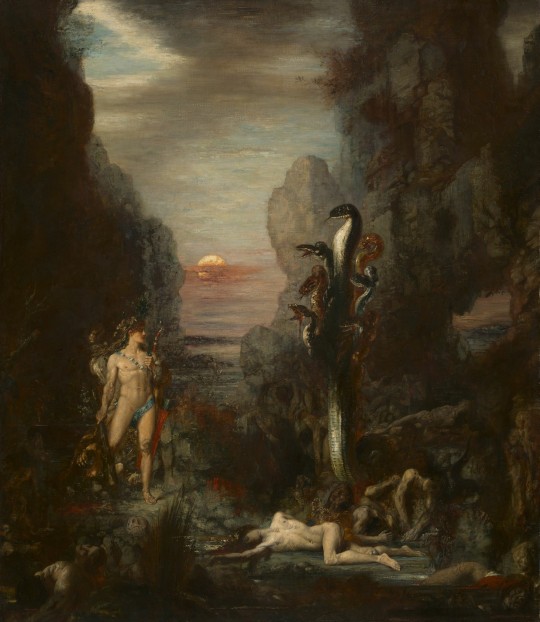Text
Danae
(Gustav Klimt 1907)

According to the myth, Danae was the daughter of King Acrisius of Argos. The King receives a prophecy from the Oracle, which foretells that he will be killed by Danae’s child. In an attempt to defy fate, he locks up his daughter in a cellar. However, the ever crafty Jupiter turns himself into golden rain and enters her room. The fruit of their union is Perseus, who years later, fulfills the prophecy and kills his grandfather.
In his painting, Gustav Klimt blends Symbolism with Art Nouveau aesthetics. In Danae, the figure of the young woman and the golden rain dominate the canvas. The purple cloth represents her royal origins and the Art Nouveau circular designs represent her female nature. The artist candidly explores female sexuality. However, the heavy ornamental style decreases the sexual tension of the piece.
#mythological#classical mythology#mythologyart#greek mythology#greek myth aesthetic#roman mythology#myth rp#hindu mythology#good mythical morning#mythra#aztec mythology#chinese mythology#incorrect mythology#egyptian mythology#mythologyedit#celtic mythology#irish mythology#mythology au#norse mythology#welsh mythology#art history#art#renaissance art#middle ages#ancient art
26 notes
·
View notes
Text
Oedipus and the Sphinx
(Gustave Moreau 1864)

In the above painting, the Greek hero Oedipus faces the Sphinx. The Sphinx was a mythological beast that had the head of a woman, the body of a lion and the wings of a falcon. According to the myth, the Sphinx terrorized the city of Thebes, asking all passersby the riddle “What creature walks on four legs in the morning, two legs at noon, and three legs in the evening?” Anyone who answered her incorrectly was instantly devoured by the beast. We can see their remains in the foreground of the painting. Oedipus solved the riddle, thus freeing the city. The answer to the riddle is “Man” – who crawls on all fours as a baby, then walks on two legs as an adult , and then finally uses a cane (three legs) in old age.
Women became a favorite subject in Symbolism, often appearing in the role of the dangerous femme fatale. It is argued that the Sphinx, a beast with a female head, symbolized the fear and anxiety men felt towards the changing status of women in the real world. However, if we look at the painting, the interlocking gaze of Oedipus and the Sphinx, also reveals the allure he felt.
4 notes
·
View notes
Text
St. Michael Vanquishing the Devils
(Luca Giordano 1664)

When some of the angels rebelled against God, Archangel Michael threw them into the depths of hell. The distorted faces of the defeated angels (now turned into the devil) screaming in despair show the brutal realism of Jusepe de Ribera's paintings. Giordano's palette, on the other hand, was influenced by Venetian painting, and this is St. It can also be seen in Michael's subtle coloring. It is unknown for which church the altar was originally designed. In the late 18th century, it was transferred from the Minorite Church in Vienna to the imperial painting gallery.
Giordano was an incredibly active painter, whose name is currently referred to with around 2,000 paintings, who has been productive for the rest of his life. Before spending ten years in Spain, he had successfully worked in Naples, Rome, Florence and Venice. During the ten years spent there (from 1692 to 1702) Giordano did major decorative work in Madrid, Toledo, and Escorial. He had an incredible ability to imitate the work of other artists; For example, here we see how inspired he was from the Spanish-Neapolitan (native to Naples city) court painter Jusepe de Ribera.
6 notes
·
View notes
Text
Hercules and the Lernaean Hydra
(Gustave Moreau 1875-76)

Gustave Moreau developed a highly personal vision that combines history, legend, mysticism and admiration with exotic and bizarre ones. Based on the romantic tradition, Moreau focused on the expression of the timeless mysteries of human existence rather than recording or capturing the realities of the material world.
Long influenced by the Hercules legend, Moreau unleashed his fruitful imagination in Hercules and the Hydra of Lernal. On an almost ancient brown mud, the seven-headed Hydra, whose dead and dying victims are a snake-like beast lying on a swampy ground. Calm and young Hercules, amidst the carnage, gun in hand, ready to cut off the seventh, "immortal" head that Hydra will later bury.
Moreau seems to have painted this mythological painting to express contemporary political concerns. He was deeply affected by France's humiliating military defeat by Prussia in 1871. Although Hercules literally personified France and Hydra represents Prussia, this monumental work depicts intense and powerfully a moral battle between the forces of good and evil, light and dark.
4 notes
·
View notes